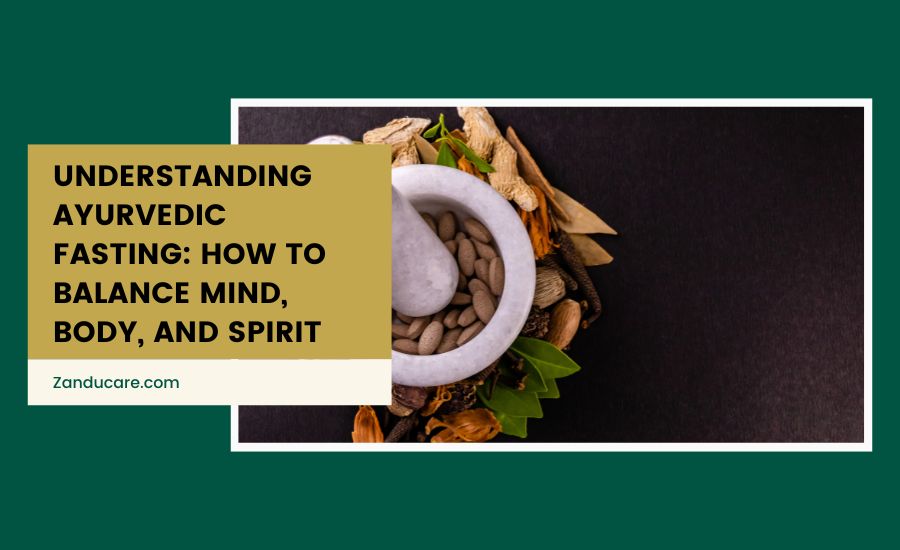
Ayurvedic Fasting Guide: Step-by-Step Process & Timings
|
Key insights:
|
Fasting in Ayurveda is more than just skipping meals; it’s an ancient approach to wellness designed to cleanse, restore, and harmonise the mind, body, and spirit. In Ayurveda, fasting is viewed as a gentle, conscious way to allow the body to detoxify and find balance, catering to each person’s unique constitution or dosha. Let's explore all about Ayurvedic fasting through this blog:
|
Did you know:
|
What is an Ayurvedic Fasting?

Ayurvedic fasting is a targeted and mindful approach to food intake aimed at restoring the balance between the mind and body. It does not necessarily mean abstaining from all food but rather focusing on eating lighter, cleaner foods that are easily digested and maximise nutrient absorption.
Moreover, it aims to eliminate mindless eating habits and promote the consumption of foods that bring the body and mind to peak performance.
It is a way of practising pratyahara, which involves consciously choosing what to put into one's body, mind, and spirit system, whether food, breath, or sensory input. One avoids what is harmful while opening up to what is beneficial for health and happiness.
Types of Ayurvedic Fasting
According to Ayurveda, there are mainly 3 types of fasting:
- Liquid Fasting: This involves consuming only warm water, herbal teas, or light broths. It’s gentle on the digestive system, making it suitable for all dosha types, especially Vata. Liquid fasting supports gentle cleansing and rejuvenation.
- Mono-Diet Fasting: In this type of fast, you eat only one easily digestible food, like kichari, a nourishing dish made from rice and mung beans. This simple diet is great for Pitta types as it provides nutrients while allowing the digestive system to rest.
- Intermittent Fasting in Ayurveda: It involves limiting one's eating to a specific window each day, often 8 hours, while fasting for the remaining 16 hours. This approach aligns well with the body’s natural cycles and can help manage body weight and energy levels.
- Complete Fasting: It means spending a day drinking only water. By this, the body’s detox system gets stimulated.
Advantages of Ayurvedic Fasting
Below are the top benefits of Ayurvedic fasting:
1. Promotes Detoxification

Ayurvedic fasting gives the digestive system a rest and allows the body to eliminate built-up toxins and impurities more efficiently. Going for periods without heavy foods enables metabolic waste and ama (toxins) to be flushed out, leaving you feeling rejuvenated. Light, easy-to-digest foods also minimise new toxin formation during the cleanse.
2. Restores Balance in Bodily Systems
Fasting Ayurvedically is tailored to balance each individual's doshas (mind-body types) and bring equilibrium to the bodily systems. For example, cooling and calming foods reduce excessive pitta while warming meals balance high vata. This constitutional balance minimises disease risk and supports optimal health.
3. Resets Unhealthy Eating Patterns
An Ayurvedic fast is an opportunity to assess dietary habits contributing to health issues and replace them with more nourishing choices. The introspection and mindful eating inherent in Ayurvedic fasting facilitates long-term positive changes rather than short-lived quick fixes.
4. Promotes Mind-Body Awareness

Ayurvedic fasting emphasises understanding the link between food, breath, sensory inputs and their impact on mind and body. This heightened self-awareness during the fast translates into greater consciousness around dietary and lifestyle choices for optimal well-being after the cleanse.
5. Lightens and Rejuvenates
The simpler, lighter foods eaten while Ayurvedic fasting gives the digestive organs a break. This rests the body, reduces fatigue, and directs stored energy towards self-healing and renewal. The result is increased lightness and vitality, setting the stage for greater health.
How to Do an Ayurvedic Fast
Here are some key points to consider before beginning an Ayurvedic fast:
1. Assess your dosha constitution (Prakriti) and current health status (vikriti). This will help guide appropriate fasting choices. If you are unsure, consult an Ayurvedic practitioner.
2. Those new to fasting or with chronic conditions should consult an Ayurvedic practitioner or healthcare provider before starting.
3. Begin by eliminating unhealthy foods for a day or few days at a time:
- Sugars and refined carbs
- Gluten
- Commercial dairy
- Unhealthy fats like margarine
- Non-organic and genetically modified foods
- Processed and leftover foods
- Frozen and fast foods
- Caffeine and alcohol
4. These substances create toxins (ama) and heaviness in the body. Eliminating them is a simple first step to prepare for longer cleanses.
5. Before fasting, assess digestion strength, toxin levels, and vitality. Based on the starting point, fasting impacts health.
Best Period of Fasting
In Ayurveda, the best time for fasting aligns with seasonal and daily rhythms to maximise the body’s natural detox capabilities. Spring is considered an ideal season for fasting, as it’s when the body naturally sheds excess Kapha (heaviness, toxins) accumulated during winter. A light cleansing fast during spring can enhance vitality and metabolism.
For daily fasting routines, fasting between dinner and breakfast (about 12–16 hours) aligns with the body’s digestive cycles, giving it time to rest and reset. Additionally, Ayurveda suggests fasting on certain lunar days, like Ekadashi (the 11th day after the new and full moon), which is believed to amplify fasting’s spiritual and detoxifying benefits. Aligning fasting with these natural cycles helps balance the mind, body, and spirit more effectively.
How to end a Fast
It is important to ease out of a fast gradually. Don't abruptly start eating heavy foods again. If you fasted for 2 days, take 2 days to transition back to normal eating. This prevents shocking your digestion or stressing your agni (digestive fire), which could cause more harm than good.
For example, after finishing a juice fast, start with light foods like fruit, hot cereal, or an easily digestible lunch.
The transition period should be equal to the length of the fast itself. So, take the same amount of time to prepare, fast, and reintroduce foods slowly post-fast. If doing a two-day pomegranate juice cleanse, eat light for two days before, two days of just juice, and two days of simple meals after.
The gradual reintroduction lets your body adjust and avoids digestive upset. It also gives time for cravings to subside. After an Ayurvedic fast, you may find healthier whole foods more naturally appealing. With patience easing out of it, the healthy habits can stick.
Individuals Unfit for Ayurvedic Fasting

Not everyone is suited for Ayurvedic fasting, as certain individuals may find it challenging or even harmful due to specific health conditions or life stages. Here are groups of people generally considered unfit for Ayurvedic fasting:
- Pregnant and Lactating Women: They need consistent nutrient intake to support the baby’s development and milk production. Fasting could lead to nutrient deficiencies for both mother and child.
- Individuals with Weak Digestion (Low Agni): Those with poor digestive fire, or "agni," may experience further weakness or digestive disturbances with fasting. They often benefit more from nourishing, warm foods than from fasting.
- People with Chronic Illnesses: Those managing chronic conditions like diabetes, heart disease, or kidney disorders should avoid fasting, as it may disrupt blood sugar levels, energy, or other vital balances in the body.
- Children and Adolescents: Growing bodies require consistent nutrition for proper development, making fasting unsuitable for most young people.
- Individuals with Eating Disorders: For those with a history of eating disorders or disordered eating, fasting can trigger unhealthy behaviours or thoughts around food.
- Elderly Individuals: Older adults often require regular nourishment to maintain strength and energy. Fasting could lead to frailty, reduced immunity, or nutritional deficiencies.
Also, check our other guides:
Conclusion
In Ayurveda, fasting is not a one-time event but a way to cultivate lifelong wellness. By aligning fasting practices with your dosha, seasonal changes, and personal goals, you can experience profound physical, mental, and spiritual benefits. Remember, Ayurvedic fasting is less about restriction and embracing balance, mindfulness, and self-care. When approached with intention and respect for your body’s natural rhythms, fasting becomes a powerful tool to enhance your quality of life, bringing you closer to holistic harmony.
FAQs
1. What is Ayurvedic fasting?
Ayurvedic fasting is a mindful, targeted approach to food intake that aims to restore balance between the mind and body. It focuses on lighter, easier-to-digest foods that cleanse the body and mind.
2. What are the types of Ayurvedic fasting?
The main types are liquid fasting, mono-diet fasting, intermittent fasting, and complete fasting. Each has a different level of food intake restriction to promote detoxification.
3. What are the benefits of Ayurvedic fasting?
Benefits include detoxification, balancing of bodily systems, resetting unhealthy eating patterns, promoting mind-body awareness, and rejuvenation/increased vitality.
4. How does Ayurvedic fasting promote mind-body awareness?
The practice creates awareness of how food intake, along with breath and sensory inputs, impacts the mind and body. This translates to better lifestyle choices.
5. What is the best season for Ayurvedic fasting?
Spring is ideal as the body naturally cleanses excess toxins accumulated in winter. Fasting facilitates this natural detox.
6. When is the best time of day to fast Ayurvedically?
Fasting daily between dinner and breakfast, about 12-16 hours, aligns with digestive cycles, allowing the digestive system to rest.
7. Should I consult an Ayurvedic practitioner before fasting?
Yes, if you are new to fasting, have a chronic health condition, or do not know your dosha prakriti/vikriti, it is best to consult a practitioner first.
References:
- Ayurvedic fasting gives the digestive system a rest and allows the body to eliminate built-up toxins and impurities more efficiently.(https://www.researchgate.net/)
- Fasting Ayurvedically is tailored to balance each individual's doshas (mind-body types) and bring equilibrium to the bodily systems.(https://www.researchgate.net/)





